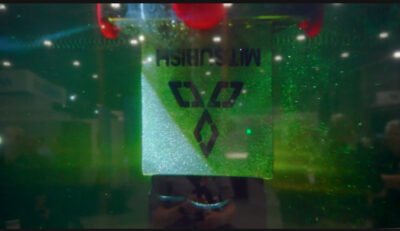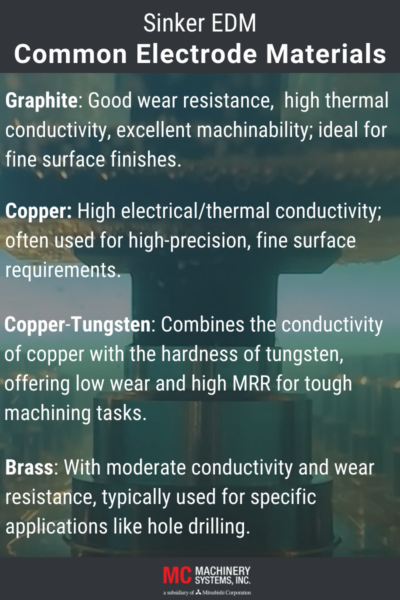
By Mitsubishi EDM Applications Engineer Adam Wysuph
In sinker Electrical Discharge Machining (EDM), the electrode material plays a crucial role in determining the efficiency, quality and precision of the machining process.
Specific ways that electrode material impacts the sinker EDM process include:
Material Removal Rate (MRR): Harder and more conductive electrode materials tend to have a higher MRR, as they can better withstand the intense electrical discharges without excessive wear.
Tool Wear Rate (TWR): Electrode materials with high wear resistance, such as copper-tungsten or graphite, reduce Tool Wear Rate, maintaining dimensional accuracy and surface finish over longer machining times.

Surface finish: The surface finish of the machined part is directly influenced by the finish electrode. Fine-grained graphite and conductive metals are capable of producing the best surface finishes. The more conductive the material the better the finish that can be achieved.
Thermal conductivity: Electrode materials with higher thermal conductivity, like copper, dissipate heat more efficiently during the EDM process. Graphite materials are very resistant to thermal electrode damage during the edm process. This allows graphite electrodes to withstand more thermally aggressive powersettings. The ability to deal with heat improves both speed and dimensional accuracy.
Electrical conductivity: The electrical conductivity of the electrode material affects the spark energy and, consequently, the effectiveness of the EDM process. High-conductivity materials have a mechanical advantage for efficient energy transfer, which can lead to more consistent machining.
Electrode machinability: The ease with which the electrode material can be shaped and machined impacts the overall efficiency of the EDM process. Materials like graphite are easy to machine into complex shapes, making them ideal for intricate EDM applications.
Compatibility with workpiece material: The compatibility between the electrode and workpiece materials is crucial. For instance, when machining hard alloys or exotic materials, a graphite electrode might be preferred due to its stability and performance under high temperatures.

Commonly Used Electrode Materials
In the North American market, graphite is the standard electrode material for EDM applications. Graphite electrodes, which enable faster roughing cycle times and cost less than other materials, are often used for steels, aluminum, Inconel and Titanium.
The use of copper as an electrode material is also quite common, but its prevalence depends on the specific application and industry. Copper is often chosen when a very fine finish is required or when machining high-precision details. It is also frequently used when working with less conductive materials. Copper is more expensive than graphite, making it cost-prohibitive for high-volume production. Unlike graphite electrodes, copper electrodes don’t produce dust during machining, making copper the preferred choice in environments where air quality is a concern.
Copper tungsten electrodes are often used for machining hard materials like carbide, stainless steel and other exotic alloys. The combination of copper’s conductivity and tungsten’s durability makes copper tungsten electrodes a preferred choice in sinker EDM for applications that require fine tolerances, precision and durability.
